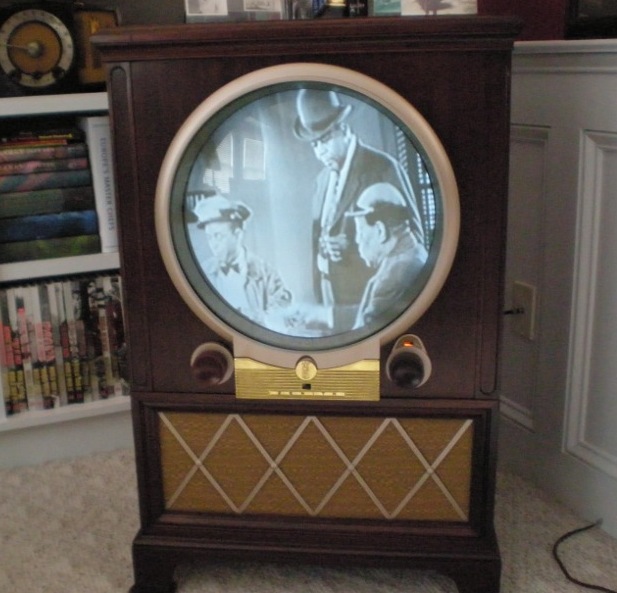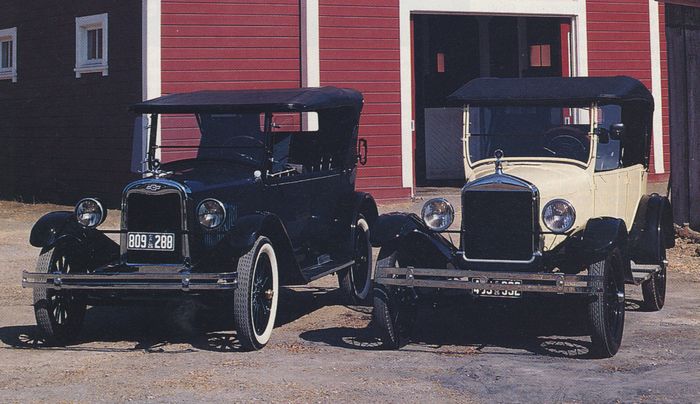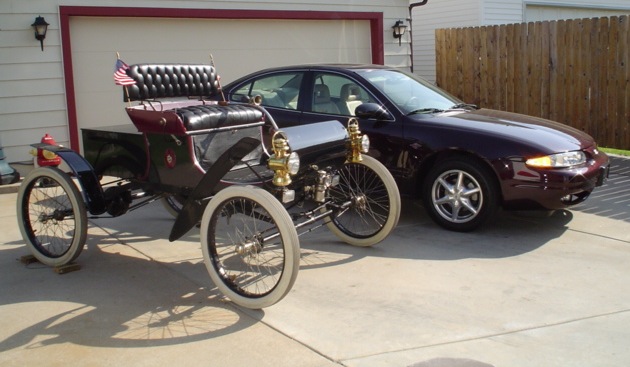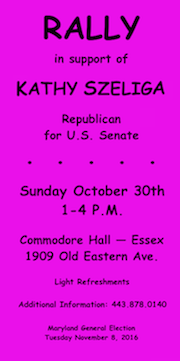
Zenith 1950s-era black & white “porthole” TV broadcasts the “Amos ’n’ Andy” show, which ran on CBS from 1951-1953 and then in syndicated reruns from 1954-1966. Back in that day, Zenith was arguably the premier American television brand, albeit in heavy competition with RCA and Philco.
HOW MANY PEOPLE TODAY EVEN KNOW
WHAT COMPANY MAKES THEIR TV SET?
Which automobile is better? — Ford or Chevrolet?
Which computer is the best? — Apple or PC?
MOST PRODUCTS NO LONGER
HAVE INDIVIDUAL IDENTITIES
OR FAMILIAR CHARACTERISTICS
By David Maril
Whatever happened to brand loyalty?
Remember not too long ago when so many American buyers were loyal to a particular company or product?
For many years, any time I purchased a television, the only type I’d consider was a Zenith. Through marketing and years of carefully crafted advertising, Zenith delivered a convincing message that “The quality goes in before the name goes on.”
When televisions adopted the printed circuit technology, we were assured that Zenith was the lone TV that was still hand-wired and therefore more reliable and easier to repair. For years, after mergers seemed to make the familiar competition like RCA and Philco disappear, we were under the impression Zenith was the only American-made option that was still around.
After Zenith was merged into extinction, Sony had the great reputation and many Zenith-type diehards made the switch to this impressive TV import.
Today, however, few people can even tell you what brand television they purchase or own.
The focus is more on the level of the screen’s high-definition, the sound system and technological options that enable you to watch a dozen football games at the same time.
The lone survivor in the world of old-fashioned brand-loyalty wars seems to be Apple vs. Microsoft in the computer world.
Most Apple technicians and users act as if they will dirty their hands if they type on the keyboard of a PC. The majority of PC people, on the other hand, laugh at Apple fanatics and believe they are strangely out of touch with reality.
Lost in the decade-long discussion about what American car companies need to survive, regaining a more dominant market share, is the loss of consumer brand-loyalty. In the 1980s, according to a recent article in the New York Times, four out of five car buyers returned to the same brand. Today, that figure has fallen to 20 percent.

Rivalry between Ford and Chevy aficionados goes back decades, possibly even to the 1926 model year as shown here, Chevrolet on the left, Ford on the right.
Decades ago, consumers actually took pride in having selected a specific brand of car or truck they felt was well-made, priced fairly and designed for reasonable and reliable service. Cars had distinctive styling characteristics.
If you owned a Ford, you denounced Chevrolets. If you bought Chevys, you were critical of Fords even though you probably had never driven one.
Several years ago, when I was living in Massachusetts, I took a Ford Mustang I owned in for its yearly inspection sticker at a service station.
The attendant greeted me with, “I am a GM guy and I hate Fords.”
These days, most of the cars in the specific category-sizes look alike, seemingly quite generic. Fords even look like Chevrolets. Or, to avoid ruffling feathers, you can also say Chevrolets look like Fords.
In the old days, you could differentiate between a Lincoln and a Cadillac from half a mile away. Today you have to look at the vehicle’s model name to determine the brand.
In contemporary times, the loyalty debates are primarily between Honda and Toyota owners as to who makes the better car. The only remnants of the Ford-Chevy rivalry battles are in the pickup truck divisions or the sports car debate between Mustangs and Camaros.
In the old days, if you were moving up in the world, a Chevy person would consider Pontiacs, Oldsmobiles and Buicks — or, at the top, the Cadillac.
Ford customers would consider moving up to a Lincoln. Plymouth devotees would consider Dodges or Chryslers.
All the cars — from Cadillacs, Chryslers and Lincolns, to Buicks, Dodges and Mercurys — had special identities and a lot of effort was put into commercial slogans.

These are not “your father’s Oldsmobile”s, but they are among the first and last of their kind. On left, the 1902 Olds, one of the first; on right, the 2004 Alero, the last. Oldsmobile ceased production at the end of April, over a decade ago.
Some favorites were:
“Plymouth’s on the move.”
“The pride is back, born in America.” (Plymouth)
“Chrysler-Plymouth, coming through!”
“This is not your father’s Oldsmobile.”
“Wide-Track.” (Pontiac)
“We build excitement.” (Pontiac)
“When better cars are made, Buick will build them.”
“Wouldn’t you really rather have a Buick?”
“Built for the road ahead.” (Ford)
“Designed for living. Engineered to last.” (Ford)
“Have you driven a Ford lately?
“An American revolution.” (Chevrolet)
“See the USA in your Chevrolet.”
“The Heartbeat of America.” (Chevrolet)
“Like a rock.” (Chevrolet)
The corporate culture has also helped diminish brand loyalty. As dealerships have merged, expanded and sell multiple brands, consumers are influenced more by discount pricing and bulk sales.
The market share for small dealerships used to be much higher. When you went in to look at cars, the sales representative already knew your buying history, how many people were in your family and what options you preferred on your vehicles.
The person you dealt with had probably sold you two or three other cars and had worked at that location for over 10 years. You’d go in, look at models and then sit down and order a car with the equipment you wanted.
Recently, when I purchased a Honda Accord, there were almost no decisions to be made over options. The model I bought came with most of the features already selected and factory installed.
In the old days, most features came à la carte. Air conditioning was optional. Some people liked tilt steering-wheels but didn’t want power brakes. There was a long menu of interior and exterior items you would order from.
![The late Dinah Shore belts out her signature song, “See The U.S.A. In Your Chevrolet,” which she sang for 10 years on early television at the conclusion of her weekly shows, which were sponsored by the Chevrolet Division of General Motors Corp. (To see video, click here.) [http://www.youtube.com/watch?v=qhR8GZ_WWMM]](http://voiceofbaltimore.org/wp-content/uploads/2014/08/ShoreDinah1950sPhoto-screenshot.png)
The late Dinah Shore belts out her signature song, “See the U.S.A. in Your Chevrolet,” which she sang for 10 years on early television at the conclusion of her weekly variety shows, that were sponsored by the Chevrolet Division of General Motors Corp. (For video, click here.)
Then, unless the exact model you wanted was in stock, you’d place the order and it could take up to six weeks for the car to be delivered to the dealer.
Although this sounds cumbersome, it actually made getting a new car even more of a big deal. The anticipation of driving around in your new set of wheels would build for the next month.
So, is brand loyalty to American cars gone forever?
It could return if U.S. carmakers put the emphasis on innovative design and reliability. Quality means more, in the long-run, than unrealistic discounts.
And, even in the cutthroat corporate world, a return to a little of the old personalized customer service might also make a difference.
We’ll know the American automakers have turned the corner if Ford buyers resume arguing with Chevy owners over who makes the better car.
davidmaril@voiceofbaltimore.org
“Inside Pitch” is a weekly opinion column written for Voice of Baltimore by David Maril.
CHECK OUT LAST WEEK’S “INSIDE PITCH” COLUMN: click here
…and read archived Dave Maril columns by clicking here.






August 9th, 2014 - 1:08 AM
[…] Voice of Baltimore by David Maril. CHECK OUT LAST WEEK’S “INSIDE PITCH” COLUMN: click here …and read archived Dave Maril columns by clicking here. […]